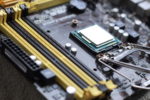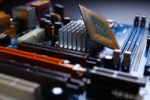Best Ryzen Motherboard: Complete Reviews With Comparisons

When building a PC, the first thing you have to decide on is whether to assemble an AMD or Intel system.
Many choose an AMD build because Ryzen CPUs are typically cheaper than their Intel counterparts.
If you decide that a Ryzen setup is your best way forward, you’ll also need a good mobo to support the system.
While the best Ryzen motherboards can cost as high as a whopping $1600, there are other worthy finds with a friendlier price tag.
The list below covers options for budget-conscious consumers or those willing to spend around 500 bucks.
Comparison Chart
Ryzen Motherboard Reviews
1. ASRock B550 Taichi
The Taichi has been one of ASRock’s most prominent flagship series motherboards.
Products belonging to the lineup always feature the latest high-end components, and they don’t cost as much as competing models from ASUS or Gigabyte.
The ASRock B550 Taichi is an outstanding option for a build using one of the latest Ryzen CPUs.
ALSO READ: Best Motherboard for Ryzen 5 2600
Review
The ASRock B550 Taichi is a high-end motherboard that sits at a price range that can be too much for entry-level consumers.
Furthermore, it is not an X570 motherboard, which means it does not support the latest improvements in “general-purpose” lanes.
If you’re not keen on maximizing any of the latest and perhaps heftily priced PCIe 4.0 devices, you can stick to a B550 machine.
- Appearance
Appearance-wise, this motherboard is unique with its antique brass accents on a black PCB.
It features the famous gold Taichi gears over the chipset and brass-colored primary heatsinks.
Aside from the steel-reinforced PCIe sockets, everything else is just black.
Other aesthetic features include built-in LED illumination on the rear panel heatsink and along the right-side edge of the board.
- Primary Components
The B550 Taichi supports CPUs from the 3000, 3000-G, 4000-G, and 5000 Series Ryzen lineups.
It allows a total memory capacity of 128GB, and it offers an overclocked memory speed of 5200MHz.
The board features outstanding expansion options with its three steel-reinforced PCIe 4.0 x16 sockets.
Additionally, it has two PCIe 4.0 x1 slots.
You can use these expansion sockets for multi-GPU setups with 2-Way, 3-Way, or Quad CrossFireX.
Unfortunately, it does not support multiple graphics cards using NVIDIA SLI.
Furthermore, populating sockets PCIe_2 and PCIe_4 downgrades the PCIe_5 to just two lanes.
For storage, you will have eight SATA 6Gbps ports, one Hyper M.2 socket, and one Ultra M.2 socket.
With these connectors, you can have all the built-in storage you need.
- Rear Panel Connectors
The rear panel of the B550 Taichi is pretty basic.
It has six USB3.2 ports, two USB2.0 ports, an HDMI, a DisplayPort, five audio jacks, and an optical S/PDIF Out port.
If you need additional USB ports, you can route eight more through internal connections.
In addition, network connectivity features include a dual-band Wi-Fi 6 module and a GigaLAN Intel I225V Ethernet port.
PROS
CONS
2. ASUS ROG Crosshair VIII Hero Wi-Fi
The Republic of Gamers features a long list of motherboards capable of running Ryzen processors, and the Crosshair Series is its flagship brand.
If you’re looking for a Grade A ASUS motherboard compatible with Ryzen, you need to look at all Crosshair models.
At least six Crosshair motherboards use the X570 chipset, one of which is the ROG Crosshair VIII Hero Wi-Fi.
If you’re gunning for a B550 build, you should look at one of the B550 ROG Strix or TUF Gaming models.
Review
With the X570 chipset, the Crosshair VIII Hero can help you take advantage of PCIe 4.0 lanes separate from the CPU’s lanes.
You can reconfigure these lanes into almost any data communication channel, as long as you pair it with PCIe 4.0 GPUs and storage drives.
In addition to the X570 benefit, the Crosshair VIII Hero provides a wide range of USB and high-end network connectivity features.
- Appearance
The Crosshair VIII Hero carries the common ROG branding with its primarily black color scheme and LED-lit ROG and Hero logos.
Massive heatsinks cover more than half of the motherboard, and the primary heatsinks have a silver accent cutting diagonally across.
- Primary Components
This motherboard can support 3rd, 2nd, and some 1st Gen AMD Ryzen processors.
Its 128GB capacity memory slots allow overclocking up to speeds of 4866MHz, and it permits the use of ECC memory.
On the expansion front, only two of its three full-sized sockets have steel reinforcement, but all can run PCIe 4.0 devices.
You can use these sockets for NVIDIA 2-Way SLI, AMD 2-Way CrossFireX, or AMD 3-Way CrossFireX.
In addition to the full-sized sockets, the board has a single PCIe 4.0 x1 slot.
Like the B550 Taichi, the Crosshair VIII Hero has eight SATA 6Gbps ports and two M.2 slots, allowing you to add crazy amounts of storage.
- Rear Panel Connectors
The rear panel on this motherboard boasts 12 USB3.2 ports, but it does away without any display connectors.
You will have to course your display output through your choice of GPUs.
This motherboard presents the best audio components among the options with its SupremeFX 8-channel HD codec, five audio jacks, and an optical S/PDIF Out port.
You can enjoy wired connections using the dual Ethernet ports and wireless connections via the dual-band Wi-Fi 6 AX200 module.
PROS
CONS
3. Gigabyte X570S Aorus Master
Just like the Republic of Gamers, Aorus is a world leader in high-performance gaming hardware and systems.
It features Gigabyte’s high-end gaming motherboards and premium graphics cards.
For the best Ryzen-based setup, you need not look further than the Gigabyte X570S Aorus Master.
Review
The Gigabyte X570S Aorus Master may require deep pockets, but it excels in all accounts of high performance.
As long as your budget fits this board’s price range, it deserves serious consideration over other similarly priced motherboards.
- Appearance
This motherboard is probably the neatest-looking board among the options.
A large heatsink covers the entire bottom half of the board, with the Aorus eagle over a silver accent surrounding the chipset.
Plus, an orange LED illuminates the Aorus logo on the rear panel heatsink, while everything else is just black and looks simple.
Steel-reinforced expansion and memory sockets highlight the silver accent on the Aorus eagle.
- Primary Components
You can use the X570S Aorus Master with Ryzen 5000, 5000-G, 4000G, 3000, 3000-G, 2000, and 2000-G Series processors.
If you like overclocking, you can tweak the RAM clock to reach speeds of 5100MHz, but you should max out its 128GB memory capacity.
Unlike the B550 Taichi or the Crosshair VIII Hero, the X570S Aorus Master does not have any x1 slots.
Nevertheless, you can use its three steel-reinforced PCIe 4.0 x16 sockets for Quad CrossFire or 2-Way CrossFire.
Unfortunately, this pricey motherboard does not support multiple graphics cards using NVIDIA SLI.
Its advantage over the alternatives, though, is its flexibility in the storage department.
Instead of having eight SATA ports and two M.2 slots, it carries six SATA 6Gbps ports and four M.2 slots.
Three of the four M.2 slots allow the installation of SATA drives.
- Rear Panel Connectors
Unlike the Crosshair VIII Hero, the X570S Aorus Master only has one Ethernet port.
Plus, it also carries the latest dual-band Wi-Fi 6 components.
With 12 USB ports, its USB connectivity is similar to the Crosshair VIII Hero, but only eight have the latest 3.2 version.
Gigabyte makes it a point to supply cheaper components that are otherwise enough for peripheral devices such as mice and keyboards.
You will find five gold-plated audio jacks and one S/PDIF Out port in the audio department of the rear panel.
This board doesn’t have any display connectors, which means you should only buy it if you have a suitable graphics card.
PROS
CONS
4. MSI MAG B550M Mortar Wi-Fi
If you’ve been building computers for a considerable amount of time, you probably already know that MSI offers more budget boards than ASUS and Gigabyte.
In fact, even MSI’s flagship MAG and MPG brands carry products that are more or less always the cheaper option.
Your best bet for an affordable next-generation Ryzen setup is the gaming performance MSI MAG B550M Mortar.
Review
Above all other features a good motherboard should have, the MSI MAG B550 Mortar focuses on gaming performance.
Even better, it comes as a strong contender for a Ryzen machine even if it is cheaper than many B550 and X570 boards.
Aside from being inexpensive, the MAG B550 Mortar can maximize its stock-clocked potential with a Zen 3 Ryzen CPU.
RELATED: Best Motherboard for i9 9900K (Guide)
- Appearance
The MAG B550 Mortar sacrifices aesthetics to put much of its value into performance.
Unlike the other options on this list, it is a micro-ATX motherboard, which means it is a bit squarish and will fit much smaller PC enclosures.
Aesthetics-wise, its design features include silver heatsinks and white diagonal printed stripes over a black PCB.
While multiple vents on the heatsinks help dissipate heat, they also work as visually appealing features that highlight the Mortar brand.
- Primary Components
This MSI motherboard only works with the Ryzen 5000, 4000-G, and 3000 Series processors.
While it will work fine with some 3000-G CPUs, it is incompatible with the 3200G and the 3400G.
If you have any of the compatible processors on hand, the MAG B550 Mortar should be enough for a good build.
Note that even if you have the maximum 128GB memory capacity, you can only overclock up to 4400MHz.
Nevertheless, you’ll like that it packs two full-sized expansion sockets and two x1 slots, even though it has a shorter micro-ATX form factor.
Plus, the main x16 socket has steel reinforcement, making it your go-to socket for a single GPU setup.
You can use two graphics cards that support 2-Way AMD CrossFire.
However, while the first x16 socket allows PCIe 4.0 connections, the second can only hold up to PCIe 3.0.
One disadvantage of this cheaper board is its fewer storage device connectors.
Compared to others on this list, it only has six SATA 6Gbps ports and two M.2 slots.
Furthermore, installing an M.2 SSD on the second M.2 slot disables the second PCIe x16 socket, canceling the multi-GPU capability.
- Rear Panel Connectors
Aside from the minimal aesthetics, this board also sacrifices USB connectivity.
Also, we don’t like that only four of the six USB ports have the latest 3.2 version.
Fortunately, the board adds a legacy PS/2 combo port.
Other connectors include an HDMI, a DisplayPort, an Ethernet port, and a dual-band Wi-Fi 6 module.
PROS
CONS
5. MSI MPG X570 Gaming Pro Carbon Wi-Fi
If you need a noticeable increase in aesthetics than a MAG board, you can choose any of the MPG and MEG Series motherboards.
However, many MEG boards can be overkill and quite as expensive as Crosshair or Aorus models.
Spending a little more than what a MAG requires means you can get one of the better MPG motherboards, including the MSI MPG X570 Gaming Pro Carbon.
Review
The MSI MPG X570 Gaming Pro Carbon gives you the best chance of exploiting the best components without breaking the bank.
The problem is, it won’t be a great option if you’re unwilling to spend a lot of money on premium components.
MSI designed it to work well with today’s available hardware and those from the foreseeable future.
If you can’t maximize its potential with high-end components, you’re better off choosing a board that’s cheaper and works well with a budget setup.
- Appearance
While the other motherboards on this list showcase straight edges and diagonal lines, the MPG X570 Gaming Pro Carbon looks more fluid.
It inserts some curves near the top-left and bottom-right corners of the PCB.
You will also find diagonal stripes on this board, but they are in sections of alternating directions.
Other design features include the MSI dragon over the actively cooled chipset and built-in LEDs on the top-left heatsink.
The MPG X570 Gaming Pro Carbon’s significant advantage over the MAG B550 Mortar is its flexible options for RGB aesthetics.
You can add plenty of RGB lights and change the light settings using the MSI Mystic Lights app.
- Primary Components
This motherboard can use any of the 5000 Series, 4000-G Series, 3rd Gen, and 2nd Gen Ryzen processors.
However, it costs much more than the MAG B550M Mortar, even when it offers similar memory capacity, overclocked RAM, and stock-clock speeds.
What’s more, it has the same amount of expansion sockets.
The good thing about the two full-sized expansion sockets is their support for PCIe 4.0 devices.
You can use two graphics cards supporting a 2-Way AMD CrossFire setup.
The MPG X570 Gaming Pro Carbon also has only six SATA 6Gbps ports and two M.2 slots for storage.
However, unlike the MAG B550M Mortar, the MPG X570 Gaming Pro Carbon does not cancel the second x16 expansion slot with both M.2 slots populated.
- Rear Panel Connectors
Another advantage of the MPG X570 Gaming Pro Carbon over the MAG B550 Mortar is its more extensive USB connectors.
While it does away without a DisplayPort, it features an HDMI port alongside eight USB ports, six of which are USB3.2 sockets.
In addition to the USBs, the board also sports a PS/2 legacy combo port.
The board has five gold-plated 3.5mm jacks and an optical S/PDIF Out port for audio.
Finally, network connectivity is also flexible between the dual-band Wi-Fi 6 AX200 module and the single Intel I211AT Gigabit LAN controller.
PROS
CONS
Which Motherboard Is Best For Ryzen?
After careful performance testing and deliberation, we found that the top Ryzen motherboard among the options is the Gigabyte X570S Aorus Master.
The ASRock B550 Taichi comes in second place with only a few points lower in cost-effectiveness.
We also found that the ASUS ROG Crosshair VIII Hero Wi-Fi can perform better than the MSI MAG B550M Mortar.
However, it loses a lot of traction in terms of cost-effectivity, as it is more expensive than any of the alternatives.
Meanwhile, choosing the MSI MPG X570 Gaming Pro Carbon over the Crosshair VIII Hero seems more practical.














